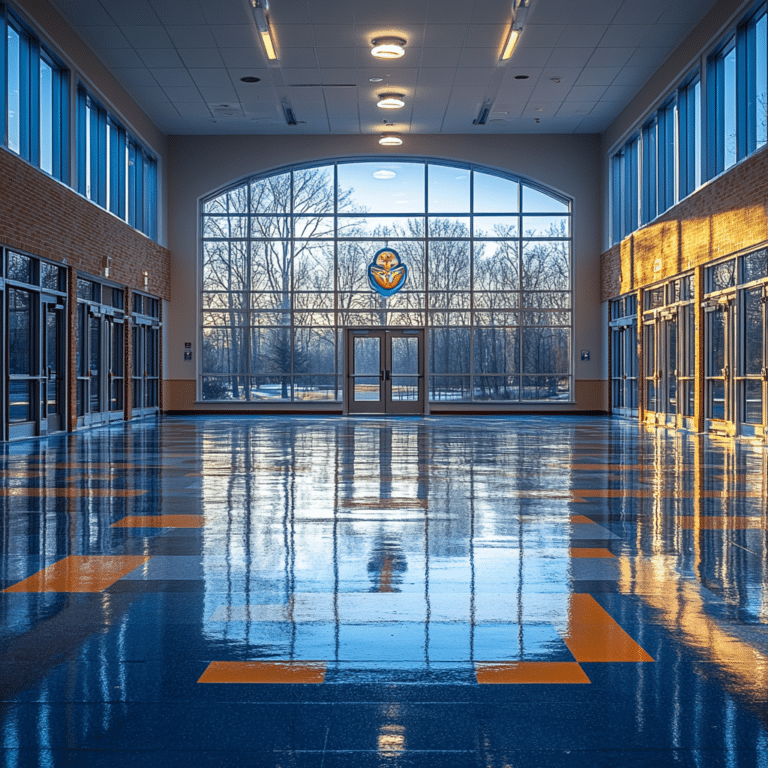
Who Was Phylicia Simone Barnes?
Phylicia Simone Barnes was a name uttered with immense pride and sorrow. A radiant high school senior from Monroe, North Carolina, Phylicia’s life was brimming with promise. She disappeared in December 2010 while visiting her half-siblings in Baltimore, Maryland. This honor student dreamed big—college was on the horizon, and her potential was boundless. Her sudden disappearance engulfed her family and the public in a whirlwind of grief and confusion, sparking a massive outcry that still resonates today.

The Day of Disappearance: What Happened?
December 28, 2010, will forever be a bleak day for the Barnes family. On that fateful day, Phylicia was staying with her older half-sister, Deena Barnes, at the Reisterstown Square Apartments in northwest Baltimore. Last seen around noon, Phylicia was preparing to meet a friend. The events following her last sighting remain shrouded in mystery. Was she taken in broad daylight? Did she leave of her own accord and meet a nefarious end? Overwhelming questions surged as exhaustive police and community searches commenced. Utilizing helicopters, search dogs, and thorough neighborhood canvassing, the search efforts yielded no sign of Phylicia. The silence was deafening.

| **Category** | **Details** |
|---|---|
| Full Name | Phylicia Simone Barnes |
| Date of Birth | January 12, 1994 |
| Date Went Missing | December 28, 2010 |
| Date Body Found | April 20, 2011 |
| Age at Time of Death | 16 years |
| Location Found | Susquehanna River, Maryland |
| Primary Suspect | Michael Johnson, then 26 years old |
| Initial Charges | Michael Johnson charged with Barnes’ murder |
| Initial Conviction | Johnson convicted in 2012 |
| Conviction Overturned | Conviction overturned in 2013 |
| Third Trial Outcome | Case against Johnson dismissed for lack of evidence in 2018 |
| Family | Parents: Russell Barnes & Janice Sallis |
| Impact | Case highlighted issues in missing persons investigations |
A Case with Twists and Turns: Investigations and Lead Dynamics
The Baltimore Police Department, aided by the FBI, embarked on one of the most baffling investigations the city had ever seen. As tips flooded in, most led to frustrating dead ends. Suspicion often fell on those close to Phylicia, including her half-siblings and their acquaintances. A prominent lead involved Michael Johnson, Deena’s ex-boyfriend. His conflicting statements and contentious history with Phylicia drew intense scrutiny. Johnson was initially charged with her murder, convicted in 2012, but that conviction was later overturned. By 2018, in his third trial, the case against Johnson was dismissed for lack of evidence, deepening the enigma of Phylicia’s disappearance.

The Community Reaction: Public Engagement and Media Spotlight
From the moment news broke, Phylicia Simone Barnes’ case galvanized nationwide attention. The media coverage, spearheaded by high-profile figures like Nancy Grace and outlets such as CNN, sustained public interest. The interest rate now comparison of media coverage highlighted glaring disparities, especially in cases involving African American women. Civic groups and advocacy campaigns emerged, while social media buzzed with the hashtag #FindPhylicia, encapsulating the urgency and despair emanating from her plight. Public participation soared—illustrated by the involvement in events like the ‘purple light’ vigils organized in her honor, where communities united in solidarity.

Comparative Analysis: Phylicia Barnes and Other Notable Cases
Comparing Phylicia’s case to other prominent disappearances, like Natalee Holloway and Tamika Huston, reveals both striking parallels and sharp contrasts. Holloway’s case received incessant and resource-abundant media coverage, in stark contrast to Huston’s, which garnered sporadic national attention. Such disparities bring to the forefront systemic biases within media coverage and the broader societal issue of safeguarding American youths. Both Holloway and Huston’s cases, much like Phylicia’s, underscore an urgent need for equitable attention and resource allocation in missing persons cases.
Continuing Legacy: Ongoing Efforts and Impact
Despite the recovery of Phylicia’s body from the Susquehanna River in April 2011, closure remains distant. Memorial services annually honor her memory, and scholarship funds bear her name. Community-driven efforts have spawned organizations focused on missing persons’ awareness and advocating for streamlined search and rescue policies. The impact of Phylicia’s story extends beyond her family, touching the hearts and igniting the determination of countless supporters aimed at preventing such tragedies.
Lessons Learned: Institutional Responses and Policy Improvements
Phylicia’s case prompted tangible changes within law enforcement and community engagement. Enhanced funding and technological upgrades for initiatives like Baltimore City’s Cold Case Unit illustrate progress. Educational programs designed to avert abductions and bolster community vigilance have emerged, showcasing practical advancements born from this tragedy. These improvements aim to provide swift assistance in similar future cases, a small solace amidst profound loss.
The Future: Hopes, Challenges, and Potential Resolutions
As the calendar turns 14 years since Phylicia Simone Barnes disappeared, numerous questions about her final days and the events leading to her end continue to linger. Renewed investigations appear sporadically, aiming to harness advanced forensic techniques and revisit old witness statements. Technologies like DNA analysis and social media surveillance offer cautious optimism that answers will eventually surface. Her family’s hope remains unwavering. The resilience displayed by her parents, Russell Barnes and Janice Sallis, stands as a testament to their enduring love and pursuit of justice.
The continuing advances in investigative methodologies hold the potential to finally piece together the full story of what transpired with Phylicia Simone Barnes. Until that day, her case remains one of the most haunting and impactful mysteries in Baltimore’s recent history, urging all of us to remember and strive for justice.
Baltimore Examiner
The Mysterious Disappearance of Phylicia Simone Barnes
Phylicia Simone Barnes, a North Carolina teenager, was on a holiday visit to Baltimore when she mysteriously disappeared in December 2010. Her case gripped both local and national audiences, not just because of its baffling nature but also due to the alarming similarities to other high-profile cases. Interestingly, the alarming incident coincided with a period when many in Baltimore were preoccupied with entirely different concerns and ongoings, such as the intense debates around well-known figures like Dave Pietramala, the lacrosse coach at Johns Hopkins University, and the ongoing buzz around local eateries spotlighting dishes like poke salad.
Many remember the case of Phylicia Simone Barnes through the media frenzy it generated. Derik Queen, a noted crime journalist, extensively covered the mysterious case, bringing much-needed attention to the investigation and giving a voice to many who were impacted. Barnes’s disappearance still invokes comparison to other unsettling cases like the tragic story of Hanako-san, a ghostly tale rooted in Japanese folklore. Such comparisons underscore the broader cultural backdrop against which her case unfolded.
Her case also brought to light societal issues surrounding youth, safety, and substance abuse, topics hotly discussed particularly in relation to studies on the impacts of ketamine drug tests. These conversations not only enriched the discourse surrounding missing persons but also pointed out the necessity for more stringent measures in ensuring the safety of young individuals.
Some intrigued by the story might remember figures like Porter Stansberry, known for his own controversies, which kept Baltimore’s residents engaged during the turbulent period Phylicia Simone Barnes’s name was stamped across headlines. It is these intertwining stories that form the complicated tapestry of Baltimore’s history, making Phylicia’s story a part of a larger narrative of community concerns and societal issues.

What happened to Phylicia Barnes?
Phylicia Barnes went missing in December of 2010, and her body was found in April of 2011. Micheal Johnson, then 26 years old, was charged with her murder. He was convicted the following year, but that conviction was overturned. In 2018, during his third trial, the judge dismissed the case against Johnson due to lack of evidence.
Who are the parents of Phylicia Simone Barnes?
Phylicia Simone Barnes was the beloved daughter of Russell Barnes and Janice Sallis.
What happened to Phylicia Rashad and her husband?
There doesn’t seem to be current information about Phylicia Rashad and her husband. This might be related to another question since Phylicia Rashad isn’t involved with the Barnes case.
What is Phylicia Rashad doing now?
Phylicia Rashad has a thriving career in entertainment and continues to take on various roles in television, film, and theater. She’s also involved in mentoring and teaching the next generation of actors.
Who is older phylicia or debbie?
Phylicia Rashad is older than Debbie Allen. Phylicia was born on June 19, 1948, while Debbie was born on January 16, 1950.
What does Phylicia Rashad daughter do?
Phylicia Rashad’s daughter, Condola Rashad, is an accomplished actress. Condola has made a name for herself in both television and Broadway productions.
Who are the parents of Ava Barnes?
There’s no information regarding any individuals named Ava Barnes linked to the details provided about Phylicia Barnes. So, if this is a different query, it should be clarified.
What happened to Barnes Wallace?
Barnes Wallis was an engineer and inventor, best known for inventing the bouncing bomb used by the Royal Air Force in World War II during Operation Chastise.
What happened to Ethel Le Neve?
Ethel Le Neve was known for her involvement with Dr. Crippen, a notorious murderer. She escaped to the U.S. with him but was later caught and tried for her part in the crime.
When did Phylicia Thomas go missing?
Phylicia Thomas went missing in February 2004. Her disappearance remains unsolved, and there have been ongoing efforts to find her or uncover what happened.



























